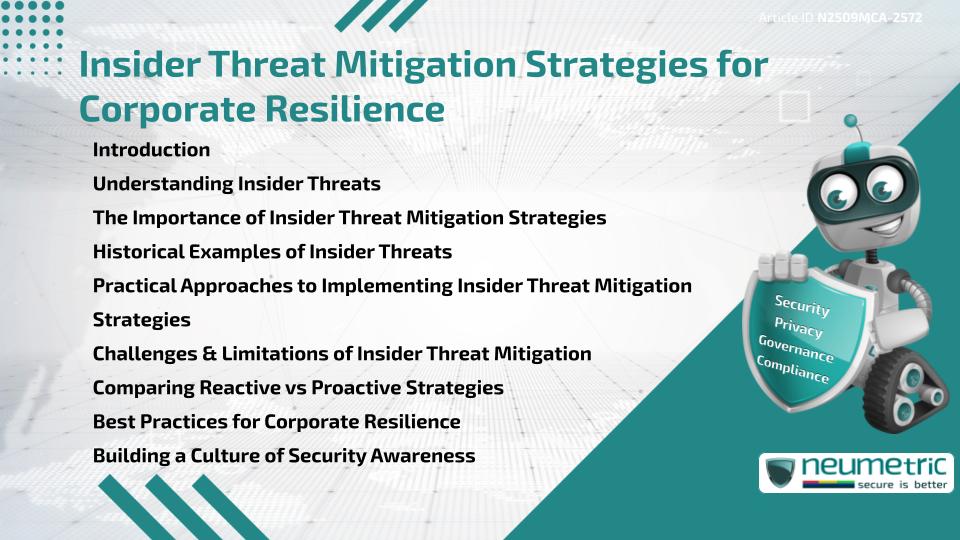Table of Contents
ToggleIntroduction
Insider Threat mitigation strategies are essential for safeguarding corporate resilience. These strategies help Organisations reduce Risks posed by Employees, contractors or business partners who may intentionally or unintentionally compromise security. By focusing on prevention, detection & awareness, companies can protect Sensitive Data, maintain trust & avoid costly disruptions. This article explores the importance, challenges & Best Practices of insider Threat mitigation strategies.
Understanding Insider Threats
Insider Threats occur when individuals with authorized access misuse their position to harm an Organisation. Threats can be malicious, such as data theft or unintentional, like mishandling Sensitive Information. Both types have the potential to cause Financial losses, reputational damage & compliance issues.
The Importance of Insider Threat Mitigation Strategies
Insider Threat mitigation strategies play a vital role in reducing Vulnerabilities. Unlike external cyberattacks, insider Threats are difficult to detect because they involve trusted individuals. Organisations must adopt layered approaches that include monitoring, Access Control & training. Without these strategies, corporate resilience is significantly weakened.
Historical Examples of Insider Threats
Several high-profile cases highlight the severity of insider Threats. From Employees leaking Intellectual Property to contractors exposing sensitive Government data, history shows that trust without oversight can lead to catastrophic consequences. These examples underline why insider Threat mitigation strategies are crucial across industries.
Practical Approaches to Implementing Insider Threat Mitigation Strategies
Companies can adopt multiple approaches to strengthen resilience:
- Access management: Restricting data access to only those who need it.
- Monitoring Tools: Using software to detect unusual activity in real time.
- Employee Training: Educating staff about the Risks of mishandling information.
- Incident Response plans: Ensuring rapid reaction when insider Risks are detected.
These steps create a layered defense that reduces the chance of Threats going undetected.
Challenges & Limitations of Insider Threat Mitigation
Despite their importance, insider Threat mitigation strategies face obstacles:
- Privacy concerns: Excessive monitoring can create distrust among Employees.
- Resource constraints: Smaller companies may lack tools or expertise.
- Complex motivations: Not all insider Risks can be predicted or identified through Standard measures.
Balancing security with organisational culture is key to overcoming these challenges.
Comparing Reactive vs Proactive Strategies
Reactive strategies focus on responding to insider incidents after they occur, while proactive strategies emphasize prevention. Proactive measures, such as Continuous Training & access restrictions, reduce Risks before they escalate. A combination of both approaches provides the most comprehensive protection.
Best Practices for Corporate Resilience
To maximize effectiveness, Organisations should:
- Conduct regular Risk Assessments
- Establish clear Policies for data handling
- Use role-based Access Control
- Foster open communication to address Employee concerns
- Continuously update monitoring & Training Programs
Building a Culture of Security Awareness
Corporate resilience depends on more than tools & Policies. Encouraging Employees to prioritise security as part of daily work reduces Risks significantly. By making security awareness a shared responsibility, Organisations strengthen defenses against insider Threats.
Takeaways
Insider Threat mitigation strategies enhance corporate resilience by combining prevention, monitoring & awareness. Despite challenges, adopting proactive measures & fostering a security-first culture ensures long-term organisational stability.
FAQ
What is considered an insider Threat?
An insider Threat is a Risk posed by Employees, contractors or partners who misuse or mishandle their authorized access.
Why are insider Threats difficult to detect?
They involve trusted individuals who already have access, making malicious or accidental misuse harder to identify.
How do insider Threat mitigation strategies support compliance?
They help meet regulatory requirements by ensuring Data Protection, Access Control & Incident Response mechanisms are in place.
Can Small Businesses implement insider Threat mitigation strategies?
Yes, even basic measures such as Employee Training & limited Access Control greatly reduce Risks for smaller Organisations.
What role does Employee Training play in insider Threat mitigation?
Training increases awareness, reduces mistakes & empowers staff to recognize suspicious behaviour early.
Are insider Threat mitigation strategies expensive?
Costs vary, but many strategies like policy enforcement & awareness programs can be implemented cost-effectively.
How often should insider Threat programs be reviewed?
At least annually or whenever significant organisational or technological changes occur.
Need help for Security, Privacy, Governance & VAPT?
Neumetric provides organisations the necessary help to achieve their Cybersecurity, Compliance, Governance, Privacy, Certifications & Pentesting needs.
Organisations & Businesses, specifically those which provide SaaS & AI Solutions in the Fintech, BFSI & other regulated sectors, usually need a Cybersecurity Partner for meeting & maintaining the ongoing Security & Privacy needs & requirements of their Enterprise Clients & Privacy conscious Customers.
SOC 2, ISO 27001, ISO 42001, NIST, HIPAA, HECVAT, EU GDPR are some of the Frameworks that are served by Fusion – a SaaS, multimodular, multitenant, centralised, automated, Cybersecurity & Compliance Management system.
Neumetric also provides Expert Services for technical security which covers VAPT for Web Applications, APIs, iOS & Android Mobile Apps, Security Testing for AWS & other Cloud Environments & Cloud Infrastructure & other similar scopes.
Reach out to us by Email or filling out the Contact Form…


